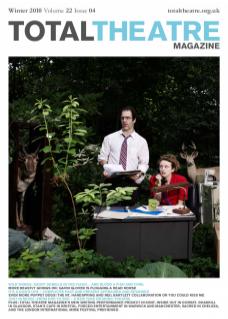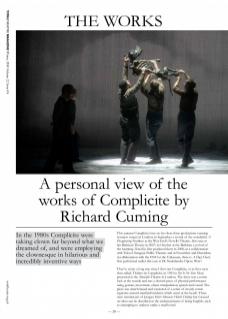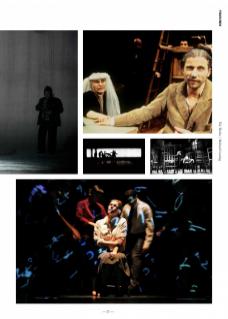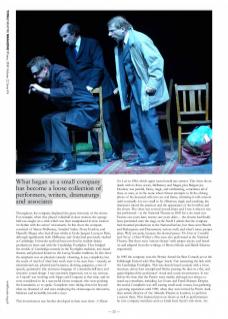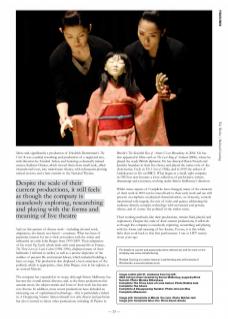This autumn Complicite have no less than three productions running in major venues in London: in September a revival of the wonderful A Disappearing Number at the West End’s Novello Theatre, first seen at the Barbican Theatre in 2007; in October at the Barbican a revival of the haunting Shun-Kin, first produced there in 2008, in a collaboration with Tokyo’s Setagaya Public Theatre; and in November and December, in collaboration with the ENO at the Colisseum, there is A Dog’s Heart, first performed earlier this year at De Nederlandse Opera. Wow!
They’ve come a long way since I first saw Complicite, or as they were then called, Théâtre de Complicité, in 1983 in Put It On Your Head, presented at the Almeida Theatre in London. The show was a comic look at the seaside and was a devised piece of physical performance using gesture, movement, object manipulation, speech and sound. The piece was sketch-based and consisted of a series of mostly comic vignettes around standard incidents which occur at the beach. These were reminiscent of Jacques Tati’s Monsieur Hulot’s Holiday but focused on what can be described as the embarrassment of being English, such as attempting to undress under a small towel.
Throughout, the company displayed the great virtuosity of the clown. For example, when they played volleyball in slow motion, the sponge ball was caught on a stick which was then manipulated in slow motion in rhythm with the actors’ movements. In this show the company consisted of Simon McBurney, Annabel Arden. Fiona Gordon, and Marcello Magni, who had all met whilst at Ecole Jacques Lecoq in Paris, although significantly both McBurney and Arden had previously studied at Cambridge University and had been involved in student drama productions there and with the Cambridge Footlights. They bridged the worlds of Cambridge comedy in the Footlights tradition, text-based theatre, and physical theatre in the Lecoq/Gaulier tradition. In this show the emphasis was on physical comedy: clowning, le jeu, complicity; but the seeds of much of their later work were to be seen here – namely, an international cast, physical performance, devising, puppetry, a mix of speech, grammelot (the nonsense language of commedia dell’arte) and inventive sound design. I was extremely impressed, not to say envious, as I myself was working with Zippo and Company at that time, and we were considered to be a successful clown company who were pushing the boundaries, so to speak. Complicite were taking clown far beyond what we dreamed of and were employing the clownesque in innovative, hilarious and incredibly inventive ways.
This inventiveness was further developed in their next show A Minute Too Late in 1984, which again toured small arts centres. This show about death with its three actors, McBurney and Magni, plus Belgian Jos Houben, was painful, funny, tragic, and exhilarating, sometimes all of these at once, as in the scene where Simon attempts to fit the oblong photo of his deceased wife into an oval frame, trimming it with scissors until eventually it is too small to fit. Hilarious, tragic and touching, the characters mixed the practices and the appearance of the bouffon and the clown. The show was revived several times and I saw it when it was last performed – at the National Theatre in 2005 for a six-week run. Twenty-one years later, twenty-one years older… the clowns had finally been permitted onto the stage at the Nash! I admit that the company had mounted productions at the National before, but these were Brecht and Shakespeare and Durrenmatt, serious stuff, and what’s more, proper plays. Well, not quite, because the devised pieces The Street of Crocodiles and Out of a House Walked a Man were also performed at the National Theatre. But these were ‘serious theatre’ with proper actors, and based on and adapted from the writings of Bruno Schulz and Daniil Kharms respectively.
In 1985 the company won the Perrier Award for Best Comedy act at the Edinburgh Festival with More Bigger Snacks Now cementing the link with the Cambridge Footlights. This was sketch-based comedy with a loose structure, about four unemployed blokes passing the time in a flat, and again displayed the performers’ visual and comic inventiveness. It was before the time that the Perrier went mainly, although not always, to stand-up comedians, including Lee Evans and Frank Skinner. Despite the award, Complicite was still touring small-scale venues, but gathering a growing reputation until 1989, when they were invited by Pierre Audi, then artistic director of the Almeida Theatre in London, to perform a season there. This featured previous shows as well as performances by core company members such as Linda Kerr Scott’s solo show Ave Maria and, significantly a production of Friedrich Durrenmatt’s The Visit. It was a radical reworking and production of a neglected text, with direction by Annabel Arden, and featuring a classically trained actress, Kathryn Hunter, which moved them from small-scale, albeit international tours, into mainstream theatre, with subsequent glowing critical reviews, and a later transfer to the National Theatre.
And yet this pattern of diverse work – including devised work, adaptation, site-based, text-based – continues. What has been of particular interest for me is their association with the writer and influential art critic John Berger from 1993-2009. Their adaptation of his novel Pig Earth, which deals with rural peasant life in France, The Three Lives of Lucie Cabrol (1994-1996), displayed many of their hallmarks I referred to earlier, as well as a precise depiction of the realities of peasant life and manual labour, which included building a barn on stage. The production also displayed a keen awareness of the political, which is appropriate, since John Berger, now in his eighties, is an avowed Marxist.
The company has expanded in its scope, although Simon McBurney has become the overall artistic director, and, as the three productions this autumn attest, the subject matter and form of their work has become very diverse. In addition, more recent productions have included an increasing use of sophisticated technology – this is particularly evident in A Disappearing Number. Simon himself not only directs and performs but also is invited to direct other productions, including Al Pacino in Brecht’s The Resistible Rise of Arturo Ui on Broadway in 2004. He has also appeared in films such as The Last King of Scotland (2006), where he played the seedy British diplomat. He has directed Dawn French and Jennifer Saunders in their live shows, and played the cameo role of the choirmaster, Cecil, in The Vicar of Dibley, and in 2010 the archest of Archdeacons in Rev on BBC2. What began as a small, tight company in 1983 has now become a loose collection of performers, writers, dramaturgs and associates, working under Simon McBurney’s direction.
Whilst many aspects of Complicite have changed, many of the elements of their work in 2010 can be traced back to their early work and are still present: an emphasis on physical characterisation, on virtuosity, comedy intertwined with tragedy, the mix of styles and genres, addressing the audience directly, complex technology with movement and gesture, silence, and of course ‘the political’ in the widest sense.
Their working methods, like their productions, remain fluid, playful and exploratory. Despite the scale of their current productions, it still feels as though the company is ceaselessly exploring, researching and playing with the forms and meaning of live theatre. For me, it is this which links their work back to that first performance I saw at LIFT twenty-seven years ago.
For details of current and past productions referenced, and for more on the company see www.complicite.org
Richard Cuming is a senior lecturer in performing arts at University of Winchester. www.winchester.ac.uk
